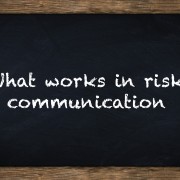Risk communication: what works and what doesn’t
The article below first appeared in the Institute for Materials, Minerals and Mining. You can find it here.
PVC 2014 took place in Brighton in April 2014. The world’s leading forum on vinyl spanned three days and delegates were treated to talks from the best in the business. On day one, Laura Shields, Brussels Director of The Media Coach presented Risk Communication: What Works and What Doesn’t. In case you missed it, or you would just like to recap, IOM3 Communications Manager, Viki Taylor, asked her how people working in science-based, technical industries can communicate better with the public.
What are the issues surrounding risk communication?
Traditionally, when science-based industries have felt under attack, they’ve either put their heads in the sand or stuck a report up on their website to contribute to the debate by putting facts out there, but without actually engaging. But we now live in an age where these not possible solutions. Firstly, digital culture and increasing public pressure mean that people are used to frequent interaction, so silence is taken as a sign of guilt. Organisations need to build trust and trust is not always rational, so if you’re trying to talk to people about the safety of what you do, sticking the facts out there regardless of whether or not your audience understands, does not help. Taking a fact-based approach isn’t always going to help – people have a gut reaction.
Are time frames important when disseminating information?
Yes. With a lot of my clients, they see a scare story and it takes them a month and several different committees to agree on a response. If people are saying things on Twitter, you don’t have a month to reply. It’s important to make sure systems are in place to respond quickly.
How do you feel about digital platforms for risk communications?
Every organisation is different. At the very least, organisations need to have someone who is listening to this stuff. I do think some kind of presence is needed. The [PVC] industry is right to be nervous about it – the internet is a heated echo chamber. But nature also abhors a vacuum, so silence isn’t really an option if damaging and untrue things are being said in conversations you aren’t taking part in.
What is your advice for disseminating scientific information?
Facts and figures do matter. There are three things that can be really helpful when talking to the public. Empathy is important, people need to feel they’re being understood. You need to talk to them, engage and listen. Secondly, you need to help them translate. Don’t give people a report and tell them to read it, you need to provide the tools to help them understand for themselves what is a problem and what isn’t. That includes pointing them to independent information, not just your own. Teach people to appreciate the difference between good and bad science by asking who’s written the report, why have they written it and when. On top of that, they need to communicate well by speaking in a language people understand outside an expert community. Keep things jargon-free and use data selectively. Science data as a tool is viewed as very powerful, but if people don’t understand it, forget it. All of this requires a degree of personalisation as well – if you hide being a position paper, it’s very easy to criticise. As soon as you bring real people into it, it’s much harder for people to do so. It’s also important to note that we process risk visually. People often respond better to visuals than words.





Leave a Reply
Want to join the discussion?Feel free to contribute!